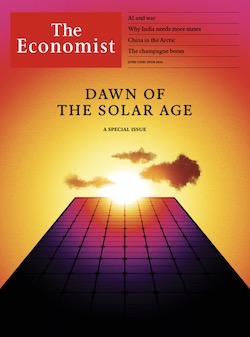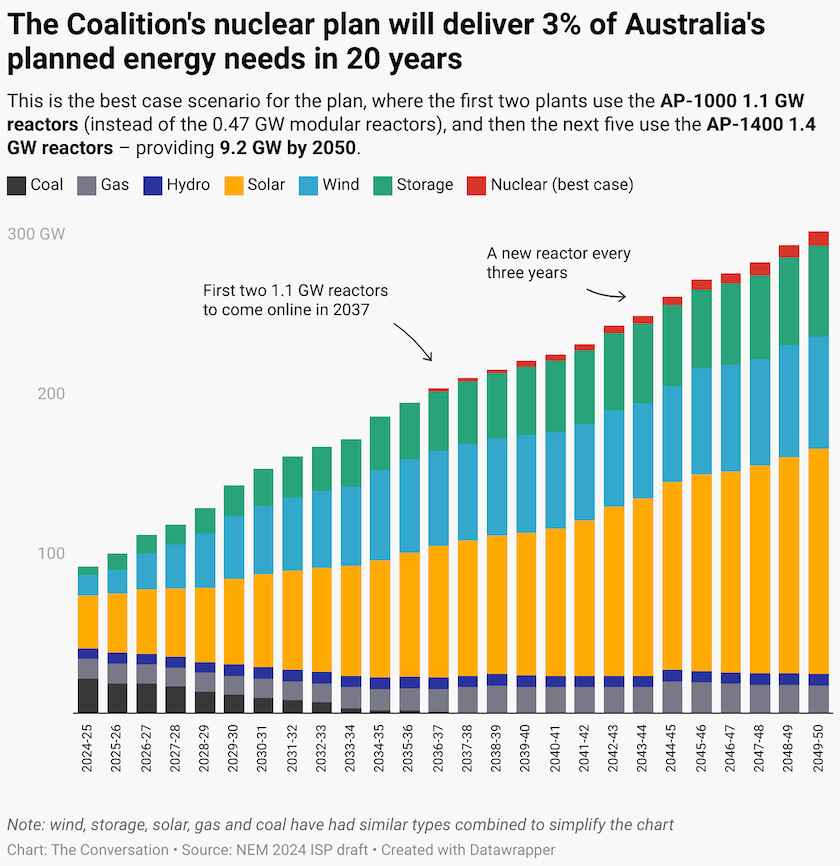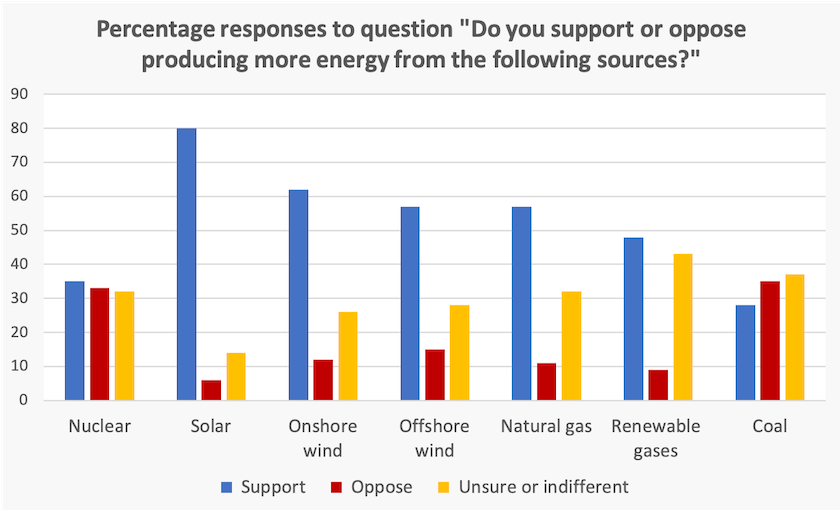The Coalition’s nuclear fantasies
Unfortunate timing

The Coalition displayed an exquisite sense of timing when it announced its nuclear policy. Just a few days after it released its policies, the Commonwealth announced that it has appointed former New South Wales Treasurer and Energy Minister Matt Kean to head the Climate Change Authority. Kean is a respected politician with a sound understanding of energy economics, who has described nuclear energy as a “Trojan horse for the coal industry”.
Then last Friday, The Economist came out with its cover-story “Dawn of the Solar Age”. To quote from its lead article:
Solar cells will in all likelihood be the single biggest source of electrical power on the planet by the mid 2030s. By the 2040s they may be the largest source not just of electricity but of all energy. On current trends, the all-in cost of the electricity they produce promises to be less than half as expensive as the cheapest available today.
Notably, while Kean has forgone the opportunity to stand for a seat in next year’s federal election, he has not left the Liberal Party. That shouldn’t surprise anyone who might have known the party in its pre-Howard days, and who has observed its competent economic management in state governments, particularly in South Australia and New South Wales.
His appointment provided the federal opposition with an opportunity to make a political comment, along the lines that Labor has such high regard for the Liberals’ economic management that they have appointed a Liberal to an important economic body. But that would be too much for the band of climate-change deniers surrounding Dutton, who consider Kean to be a pariah.
Filling in the Coalition’s blanks
The ABC’s Tom Crowley reminds us that the Coalition won't say how much nuclear power its plan will generate until after an election.
The Coalition is trying to convey the impression that nuclear energy will be doing the heavy lifting in power generation, replacing the part once played by coal. In reality nuclear power would play only a minor role, according to best estimates calculated by Roger Dargeville of the Monash Energy Institute in his Conversationcontribution: How would a switch to nuclear affect electricity prices for households and industry?. The diagram below, taken from his article, shows just how minor a role nuclear energy would play in generating electricity, and how long it would take to achieve even that minor role.

In short, it would be a very expensive increment to our electricity supply, and because of its inflexibility it wouldn’t even have a firming role: that would have to be served by gas, as is the government’s vision (unless, as is likely, battery technology advances). Dargeville calculates that the addition of nuclear would add substantially to electricity prices, for both industrial users and households.
Also writing in The Conversation Tony Wood of the Grattan Institute comes to much the same conclusion in relation to prices: Peter Dutton’s nuclear energy policy will do nothing to ease Australians’ hip-pocket pain, now or in the future. He explains that Dutton’s plan would see gas taking a much more prominent role, well beyond firming, which means it too would be contributing to higher prices, while worsening our emissions.
Public attitudes
The Canberra press gallery has assumed that because Dutton seized the political agenda he has landed a political blow on the government. The logic of that assumption is hard to follow. Surely there is no political gain to a party that puts up a proposal that is opposed by almost all experts and by a substantial proportion of senior people in the same political party.
Its political success or failure will depend on the public’s reaction, and early signs are that while concern with the safety of nuclear power is largely behind us, the public are generally going along with the government’s renewable energy path.
The Coalition and some media have taken notice of opinion polling showing that we’re not opposed to nuclear power. It’s not surprising that aversion to nuclear power has lessened. The 1979 Three Mile Island accident is a distant memory. There was Chernobyl in 1986, but we have always been dismissive of Soviet engineering (often falsely). Fukushima was only 13 years ago, but not even the Liberals would be silly enough to place a plant close to the shore in a region known for tsunamis. In terms of immediate public safety, nuclear energy rates way ahead of coal, and even of hydro, when one considers the possibility of dam failure.
But there is still the issue of disposal of nuclear waste – a problem easily kicked down the road. Rosemary Hill of James Cook University and Ian Lowe of Griffith University cover nuclear waste in their Conversation article Nuclear energy creates the most dangerous form of radioactive waste. Where does Peter Dutton plan to put it?.
There is still some public fear of nuclear power. In electorates that would host the Coalition’s reactors there may be scare campaigns: we have already seen the puerile three-eyed-Blinky Bill campaign. Such messages may have some traction among the Coalition’s support base of uneducated voters, but opponents of nuclear energy would be well advised to steer clear of them, because they distract from the main issues of cost, timeliness and inflexibility, and they are easily dismissed.
William Bowe’s Poll Bludger, reporting on people’s attitudes – Nuclear Fallout – notes that a Freshwater Strategy poll finds that in the electorates the Coalition has proposed for reactors, more voters support than oppose the plants.
These results may simply reflect the fact that these non-metropolitan electorates (listed in an ABC article by Tom Crowley and Jane Norman) are almost all held by the Coalition, the only exception being Hunter. National polling finds far less support for nuclear energy.
Freshwater Strategy includes attitudes to power sources in their national data stream polls. It’s worthwhile following the link for a rich source of surveys. In general they find we’re strongly in support of solar energy, while nuclear comes in just above coal, which occupies last place. Even so, more people support nuclear power than oppose it, although there are strong gender differences – women certainly don’t like nuclear power. And there are predictable partisan and age differences.
Annabel Crabb draws on similar polling by Redbridge in her article Peter Dutton is a true believer in nuclear as the answer to Australia's energy problems. But he'll need to convince the voting public. Their polling gives broadly similar results to Freshwater’s: more people support nuclear than oppose it, but people are far more supportive of other power sources, particularly solar. This is shown in the diagram below.

In the same article Crabb shows support for nuclear power classified by a number of voters’ characteristics. The same partisan and age differences appear as in the Freshwater poll, and the gender difference is very strong: women have a net 21 percent opposition to nuclear power, while men have a net 25 percent support.
The polls mentioned above have two limitations, however.
First, we don’t know why people like or dislike nuclear power. To what extent do opinions reflect immediate safety fears, concern about nuclear waste, economic considerations, or possibly even a visceral dislike of the Coalition? Some who have no objection to nuclear in principle may be very sceptical about anything that involves big capital projects when they think of cost overruns and delays. That’s a point made by the ABC’s David Chau and Clint Jasper: Barriers, hurdles and roadblocks litter the long road to the Coalition's nuclear future. Snowy 2.0 comes easily to mind as a big energy project that’s way over budget and is severely delayed, while smaller battery-based firming projects keep popping up with little fuss.
And second, a question about support for or opposition to a proposal involving public expenditure doesn’t tell us much. We would surely find strong support for a very fast train linking mainland capitals, free prescription pharmaceuticals, and smaller class sizes in public schools, unless respondents are reminded of the costs of these proposals, particularly the opportunity costs: if you have X you may not be able to have Y.
That’s why we should look to polls about the Coalition’s specific policies, and their costs.
Poll bludger reports on a Resolve Strategic poll, concerned with the Coalition’s nuclear energy proposal. As with other polling it finds net support for nuclear power – (41 percent support, 37 percent oppose), but it also finds 43 percent support for “Labor’s plan to use 100% renewables (supported by gas for the next decade or two)”, compared with 33 percent for “the Coalition’s plan to use nuclear power and some gas to support the renewables”.
The Australia Institute has specific polling on people’s willingness to pay for nuclear power. People are asked how much more a year they would be willing to pay to have nuclear power in the mix – nothing, up to $250 a year, up to $500 a year, and more than $500 a year.
“Nothing” dominates, with 65 percent support. There is some predictable partisan difference but it is not strong. Surprisingly, however, 23 percent of respondents would be prepared to pay something – most commonly they go for “up to $250 a year”. The only rational explanation is that those respondents do not believe renewables can be firmed at a reasonable cost. That is where the government and the industry have work to do, countering the superficially appealing argument about what to do when the sun doesn’t shine and the wind doesn’t blow, and countering the dated idea that a power system needs a “base load” generator.
Assumed in many of these surveys is that Dutton has set the agenda in terms of a Labor vs Coalition contest over nuclear power. Writing in The Conversation Mark Kenny reminds us that voters have other choices, and Dutton’s strategy could be a political gift to independents and the Greens. When the Coalition reminds electors that the government may not meet its 2030 targets, that may work to the Greens’ political advantage.
Crispin Hull has a provocative post on his website Kill climate war with election now. It’s well-argued, particularly where he points out the absurdity of a “free enterprise” party proposing public ownership while the “socialist” government is relying largely on market forces. But the alternative political view is that over the next few months the public should come to understand the costs and delays in the Coalition’s ideas.
Political tactics
Journalists and other commentators are trying to make sense of Dutton’s tactics. To misquote John Hewson, has Dutton written the shortest suicide note in Australia’s political history? Or is he the true master of political manipulation?
Writing in The Conversation Diane Sivasubramaniam and Samuel Wilson note that the Coalition intends to push its proposals through without consultation, because an election win would give it a clear mandate, even though it wouldn’t have released costings. No nuclear veto: if the Coalition isn’t seeking community consent, is that really consultation?. The ABC’s Ian Verrender draws attention to the confusing message when a party nominally on the right turns to a “big government” policy: Peter Dutton's nuclear power plans are an ironic backflip to nationalisation for the Liberal Party.
The ABC’s energy reporter explains the incompatibility of nuclear and renewable power sources. They cannot complement each other, as he explains in his post Is rooftop solar a fatal flaw in the Coalition's grand nuclear plans?. The political relevance of this point is that if nuclear energy is to justify itself economically, it will probably have to be given precedence in the day-to-day and hour-to-hour energy market in order to re-pay its massive debt. That would mean shutting off solar and wind supplies, which wouldn’t go down well with those who have made investments in these technologies, including the millions of households that have gone for rooftop solar – who are already peeved about the low price of feed-in tariffs.
Some of the Coalition’s claims are extraordinary, such as its misrepresentation of the cost of the government’s plan by a factor of ten, or the idiotic assertion that there would be only tiny amounts of nuclear waste. These don’t qualify as the type of reasoned counter-arguments an opposition might put forward. Maybe they reflect a dearth of economic and engineering knowledge in the Coalition’s ranks, or, possibly, a Trumpian attempt to add to confusion and uncertainty in a post-truth world.
John Hewson, writing in The Saturday Paper – Dutton’s far-right fantasy – doesn’t bother to go into the specific issues around nuclear power, because he believes that Dutton knows full well that it is infeasible. Rather “He probably knows it can’t ultimately be delivered as he has described, which will allow the party to fall back on coal and gas – to the delight of its fossil fuel donors.”
Paul Keating, writing in Pearls and Irritations is more direct. Peter Dutton is a charlatan – an inveterate climate change denialist.